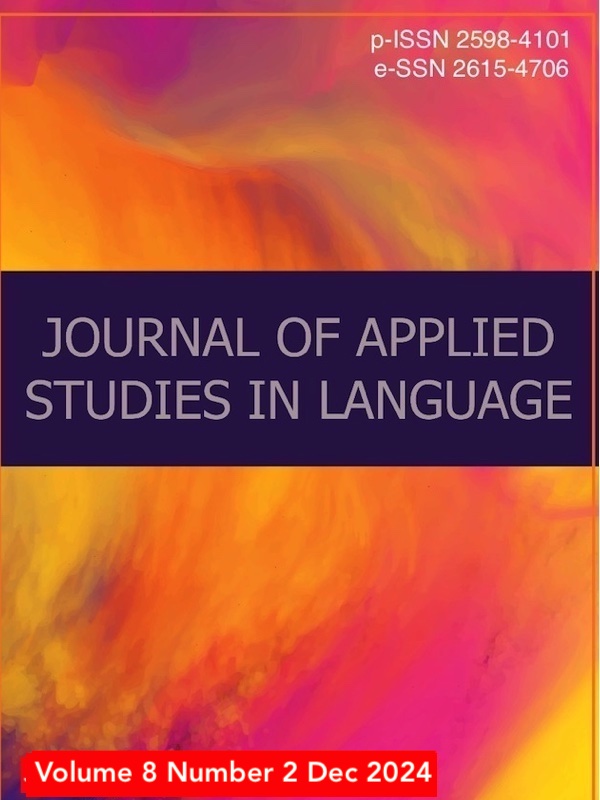Impact of SQ4R on reading comprehension of university students in an English for specific purposes (ESP) Course
Abstract
This study aimed to achieve three objectives: to identify the active reading strategies employed by undergraduate students in an English for Specific Purposes (ESP) course, to evaluate the effectiveness of the SQ4R model in enhancing students' reading comprehension, and to know their insights about the model. Descriptive analysis of survey data revealed significant positive changes in study strategies following the SQ4R intervention. Students demonstrated notable improvement in organizing material using flow charts, indicating enhanced capability in managing complex information. Similarly, highlighting techniques became more strategic, focusing on critical information. The organization of annotations into various formats also improved, pointing to more advanced note-taking and data processing skills. Additionally, the creation of practice tests increased, signifying greater engagement in active recall and testing. These findings underscore a significant shift toward more effective and engaged learning strategies among students. T-test results revealed a significant improvement in pre-test and post-test scores, confirming the effectiveness of the SQ4R model. Students' positive feedback further supports the utility of this model in enhancing active reading practices. The implications of this study suggest that the SQ4R model can be an effective tool in improving reading comprehension and engagement in ESP courses, with potential applications in other educational contexts as well.
Full text article
References
Albaker, B. A. (2021). Digital versus longhand note-taking effect on students’ knowledge,
satisfaction, and academic performance among medical students in
Majmaah University. P J M H S, 15 (4), 1509-1513.
Alptekin, C. (2002). Towards intercultural communicative competence in ELT. ELT Journal, 56(1), 57-64.
Anderson, N. J. (1991). Individual differences in strategy use in second language reading and testing. Modern Language Journal, 75(4), 460-472.
Auster, E. R., & Wylie, K. K. (2006). Creating active learning in the classroom: A systematic approach. Journal of Management Education, 30(2), 333-353.
Baron, N. S. (2017). Words Onscreen: The Fate of Reading in a Digital World. Oxford University Press.
Bell, J. T., & Kahrhoff, J. (2006). Active learning handbook. Saint Louis University, Reinert Center for Teaching Excellence.
Behnsen, J. (2018). Active learning: Theoretical perspectives, empirical studies and design criteria. Education Sciences, 8(4), 209.
Blerkom, M. L. V. (2009). College Study Skills: Becoming a Strategic Learner. Wadsworth, Cengage Learning.
Bruner, J. S. (1961). The act of discovery. Harvard Educational Review, 31(1), 21-32.
Chen, C. M., Cheng, Y. S., & Chew, S. L. (2013). Enhancing reading comprehension with online text annotation and summarization. British Journal of Educational Technology, 44(2), 181-194.
Cohen, A. D. (1986). Mentalistic measures in reading strategy research: Some recent findings. English for Specific Purposes, 5(2), 131-145.
Dudley-Evans, T., & St John, M. J. (1998). Developments in English for Specific Purposes: A multi-disciplinary approach. Cambridge University Press.
El-Kaumy, M. T. S. (2004). Metacognition and reading comprehension: Current trends in theory and research. Journal of Research in Reading, 27(1), 1-12.
Grabe, W. (2009). Reading in a second language: Moving from theory to practice. Cambridge University Press.
Goodman, K. S. (1967). Reading: A psycholinguistic guessing game. Journal of the Reading Specialist, 6(4), 126-135.
Gough, P. B. (1972). One second of reading. Visible Language, 6(4), 291-320.
Johnson, D. W., Johnson, R. T., & Smith, K. A. (1998). Cooperative learning returns to college: What evidence is there that it works? Change: The Magazine of Higher Learning, 30(4), 26-35.
Koda, K. (2005). Insights into second language reading: A cross-linguistic approach. Cambridge University Press.
Khusniyah, N. L. (2020). Teacher’s Perception on SQ4R in English Reading ComprehensionLearning Using Zoom Application. VELES Voices of EnglishLanguage Education Society, 4(2), 231–238.https://doi.org/10.29408/veles.v4i2.2554
Laufer, B., & Ravenhorst-Kalovski, G. C. (2010). Lexical threshold revisited: Lexical text coverage, learners' vocabulary size, and reading comprehension. Reading in a Foreign Language, 22(1), 15-30.
Manz, S. L. (2002). Teaching reading comprehension strategies to students with learning disabilities: A review of research. Review of Educational Research, 72(2), 277-320.
Masharipova, D., & Mizell, H. (2021). Enhancing EAP students’ reading comprehension skills through SQ4R strategy. Journal of Language and Education, 7(1), 45-53.
McDaniel, M. A., Roediger, H. L., & McDermott, K. B. (2009). Generalizing test-enhanced learning from the laboratory to the classroom. Psychonomic Bulletin & Review, 16(1), 200-215.
Mikulecky, B. S. (1990). Teaching reading as a thinking process. Harper & Row.
Nuttall, C. (1982). Teaching reading skills in a foreign language. Heinemann Educational Books.
O'Brien, D., & Voss, M. (2011). Reading comprehension in the digital age. International Journal of Digital Literacy and Digital Competence, 2(3), 25-39.
Palilonis, J. & Butler, D. (2015). Active Reading Experience Questionnaire: Development and validation of an instrument for studying active reading activities. Journal of Interactive Learning Research, 26(3), 271-287. Waynesville, NC: Association for the Advancement of Computing in Education (AACE). Retrieved June 23, 2024 from https://www.learntechlib.org/primary/p/147364/.
Pauk, W., & Owens, R. J. (2010). How to Study in College. Wadsworth, Cengage Learning.
Rahman, S. F., Sahid, S., & Nasri, N. (2022). The impact of active learning strategies on students' academic performance. Journal of Educational Research and Practice, 12(2), 123-138.
Renandya, W. A., & Jacobs, G. M. (2002). Extensive reading: Why aren't we all doing it? In J. C. Richards & W. A. Renandya (Eds.), Methodology in language teaching: An anthology of current practice (pp. 295-302). Cambridge University Press.
Roast, A., Harris, A., & Pinder, S. (2002). Strategies for teaching reading. Educational Research Review, 1(1), 3-15.
Smith, F. (1971). Understanding reading: A psycholinguistic analysis of reading and learning to read. Holt, Rinehart and Winston.
Siegel, J. (2023). Pen and paper or computerized notetaking? L2 English students’ views
and habits. Computer and Education Open 4 (2023).
Sun, D., & Li, Y. (2019). Effectiveness of digital note-taking on students’ performance in declarative, procedural and conditional knowledge learning. International Journal of Emerging Technologies in Learning (Online), 14(18), 108-119.
Taylor, A. G. (1986). Learning to Learn: Maximizing Your Performance Potential. Chandler House Press.

